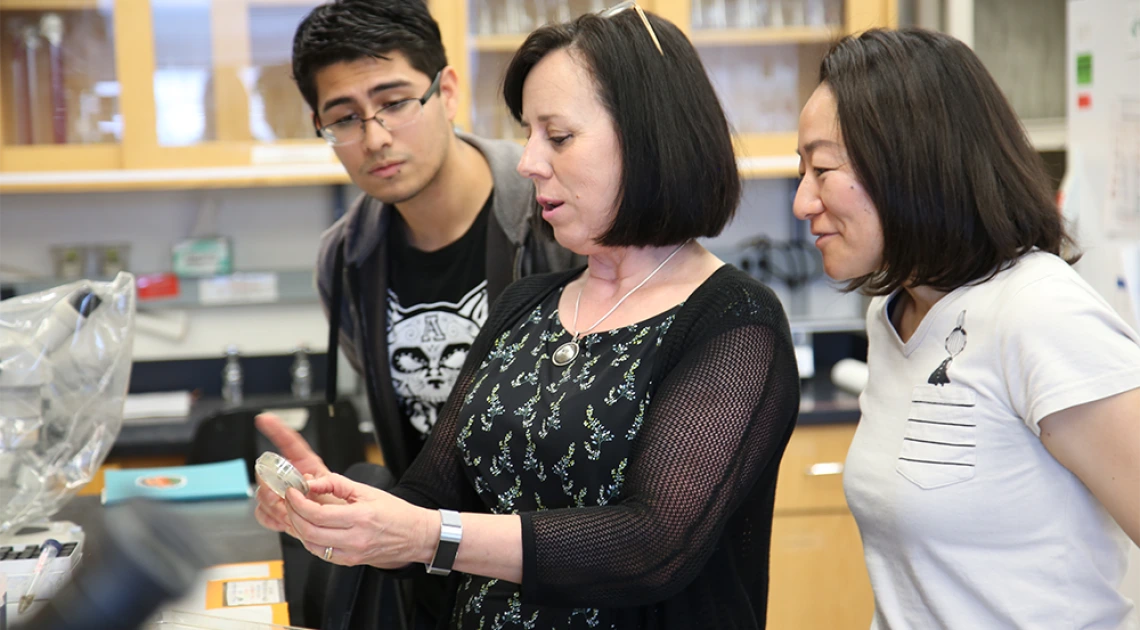Tech Blog: Finding an Alternative to Pesticides

|
Watch the new episode of Invented Arizona, where Patricia Stock has discovered compounds to replace harmful chemical pesticides.
|
Patricia Stock, PhD, professor at the University of Arizona Department of Entomology, Interim Director of the School of Animal and Comparative Biomedical Sciences and a researcher at the BIO5 Institute, has discovered compounds derived from an insect opathogenic bacterium, Photorhabdus, that have antimicrobial and nematicidal properties that can potentially replace the use of harmful chemical pesticides.
We had the opportunity to get an inside look at Dr. Stock’s lab, where she explained the process of testing the activity of secondary metabolites.
TLA: So, tell us a little about the background of your invention.
Stock: In the United States alone, plants are subject to attack by over 50,000 different pathogens, including fungi, viruses, bacteria, insects and nematodes. Although a variety of chemical and other management tools are available, none is ideal with respect to environmental safety, efficacy and/or costs. Evidence exists that the intensive use of chemical pesticides for control of plant parasitic nematodes and other plant pests like bacteria and fungi has led to severe negative environmental impacts. The EPA is in the process of reviewing the use of organophosphate and carbamate pesticides with the intention of phasing out obsolete and toxic chemicals. That has already happened with methyl bromide, a soil fumigant that had been widely used for controlling plant-parasitic nematodes and other soil biorne pathogens. Although antibacterial compounds such as streptomycin and oxytetracycline may be less problematic than the above-mentioned pesticides, these antibiotics are currently licensed for use in crop protection. They are now rarely used in human medicine because of the danger of toxicity.
TLA: What problem does it solve?
Stock: There is an urgent and present need to identify alternatives to chemical pesticides and current antibiotics for more rational and safer crop management against plant-parasitic nematodes and bacteria alike.
TLA: Who would be the top beneficiaries of a technology like this?
Stock: Farmers, who will have a safer choice for dealing with plant pests and pathogens. People, wildlife and the environment in general will be less exposed to noxious chemical pesticides.
TLA: What are you most excited about with this going forward?
Stock: Our work has been done under laboratory conditions and at a small scale. Our next step is to move to greenhouse trials first and field testing in the near future. It would be great to team up with industry to get their support and form a partnership to move forward to the next step.
TLA: Who funded the research?
Stock: Because we started as a pilot project to collect preliminary data, our funding came from the UA Accelerate for Success Seed grant, and also from CALS Innovation Venture Investment Funds. We hope to get funded in the future by the USDA or another federal funding agency.
Interested in learning more about this invention? Would you like to talk to us about licensing opportunities? Visit the link below for details and contact information.
UA17-246: Nematicidal and Antimicrobial Activities of Secondary Metabolites From Photorhabdus Bacteria With Applications in Agriculture
Also, check out these related technologies:
UA15-198: Aflatoxin Free Crops
UA17-206: Soybean as a Protein Biofactory Platform to Produced Epidermal Growth Hormone
Updated 3/29/19: KGUN 9 News covered Dr. Stock and this technology on its evening news broadcast: UA researchers looking for natural alternatives to chemical pesticides(link is external)

